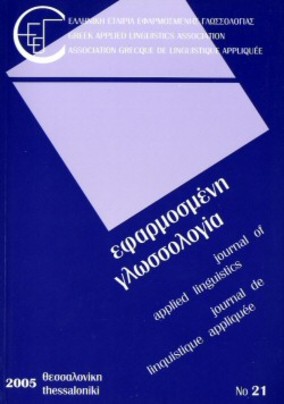Evaluations of speech variations in bilinguals
Part of : Εφαρμοσμένη γλωσσολογία ; No.28, 2013, pages 113-128
Issue:
Pages:
113-128
Author:
Abstract:
Two types of oral text, produced in the LI (Greek) and L2 (German) during the course of a study of 75 bilingual Greek pupils aged between 12 and 17 who had remigrated from Germany to Greece, are evaluated by non-linguists from the German and Greek language communities on the basis of three evaluation dimensions: Accent, linguistic performance, and assumed length of time spent in Germany. A correlation analysis and factor analysis of the data show that, on the one hand, LI and L2 as non-dependent variations elicit independent evaluations from representatives of the respective language community. On the other hand, they can also be interdependent, albeit to a minor degree. The factors, which are made up of language-specific evaluations, the evaluation dimensions and the two types of oral text, have a specific relationship to non-linguistic variables such as the length of time actually spent in Germany and variables that indicate closeness to or distance from the German and Greek language community and culture.
Subject:
Subject (LC):
Notes:
We thank Angeliki Kiliari, Professor of German Studies at the German Institute of the Aristotle University, Thessaloniki, Greece, for her help in recruiting the sample for the study, data collection and data coding., Περιέχει πίνακες, σημειώσεις και βιβλιογραφία
References (1):
- Dunbar, R. (1996). Grooming, Gossip and the Evolution of Language. London, Boston:faber and faber.Flege, J.E. (1987). The production of ‘new' and ‘similar ’ phones in a foreign language:Evidence for the effect of equivalence classification. Journal of Phonetics, 15: 47-65.Flege, J.E. (1995). Second-language speech learning: Theory, findings, and problems.In W. Strange (ed.), Speech Perception and Linguistic Experience. Timonium, MD:York Press, 233-277.Flege, J.E. (2007). Language contact in bilingualism: Phonetic system interactions. InJ.Cole and J.I. Hualde (eds). Laboratory Phonology 9, Berlin: de Gruyter, 353-381.Hopf, D. (2005). Zweisprachigkeit und Schulleistung bei Migrantenkindern. ZeitschriftfürPädagogik, 51: 236-251.Lambert, W.E. (1967). The social psychology of bilingualism. Journal of Social Issues23:91-109.Lindi,P. (2009). Rethinking Language, Mind, and World Dialogically: Interactional andContextual Theories of Human Sense-making. Charlotte, NC: Information Age Publishing.MacKay, I. and J.E. Flege (2004). Effects of second language learning on the durationof first and second language sentences: The role of suppression. Applied Psycholinguistics 25: 373-396.Singleton, D.M. and L. Ryan (2004). Language Acquisition: The Age Factor. Clevedon:Cromwell Press.Yeni-Komshian, G., J.E. Flege and S. Liu (2000). Pronunciation proficiency in the firstand second languages of Korean-English bilinguals. Bilingualism: Language and Cognition, 3:131-150.




